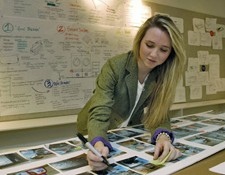
Top Firms Select UC as 'Innovation Incubator'
The University of Cincinnati Board of Trustees today approved UCs entrance into an unusual consortium agreement that will link faculty and students with corporations seeking new product and service innovations for those aged 50 and over. This new business-university model is called the Living Well Consortium.
Pioneering private-sector members joining UC in the consortium are
- Consumer-products giant Procter & Gamble Co.
- Food corporation General Mills, Inc.
- Financial services provider CitiGroup, Inc.
- Advocacy and service group AARP.
- Medical supply firm Hillenbrand Industries, Inc.
- Design and branding firm LPK.
The model works quite simply. These firms will come to UC students regarding specific product concepts for responding to 50+ market segments and building brands. The UC students and faculty will conduct research and develop ideas within an interdisciplinary environment encompassing design, engineering, business, medicine and anthropology.
The objectives and benefits of the consortium are
- To provide greater insights and information regarding the 50+ market.
- To tap a new source of growth - the 50+ consumer.
- To respond to the 50+ consumer with new solutions for better lives since the unique needs of this consumer are currently underserved.
- To build the innovation capabilities of all involved.
- To stimulate economic development in Ohio and the region.
- To test a university-business model that may later be expanded.
This new consortium targets the 50+ segment for the simple reason that the world has never before seen such a powerful market in terms of sheer numbers, buying power and consumer expectations. For instance, by the year 2050, half the world will be over the age of 50, and the buying power of the 50+ market in the United States alone is $3 trillion.

Craig Vogel
Craig Vogel, director of the Center for Design Research and Innovation at UC, has been key in helping to form the consortium, and he pointed to himself as the typical 50+ consumer that the consortium will seek to serve. He said, I accept the challenge of being over 50 while still wanting to live very fully. Im like a lot of the 50+ crowd in that I need invisible supports to help me stay at my best and achieve my individual goals. Its about meaningfully improving my life. For instance, I wear special Z-Coil shoes because I have arthritis in my back, but these shoes dont look arthritic. In fact, people think their unique design is more about sports, how high can I jump in these things.

Vogel's Z-Coil shoes
Larry Huston, former vice president for Innovation and Knowledge at P&G, also helped to form the consortium, and he explained that the network effect is key. He said, The more connections any company or university has, the better. At P&G, we will reward innovations proudly found elsewhere. Its not about know-how anymore, its about know-who. Many of us in corporations long ago turned to co-invention with our suppliers. Its a logical next step to turn to universities in a co-creative model.
In fact, this business-university model represented by the Living Well Consortium was test driven over spring quarter as part of a studio course within UCs internationally ranked College of Design, Architecture, Art, and Planning when students researched and then designed new concepts related to P&Gs Iams pet-food line to better meet the needs and wants of the 50+ market. And it worked, according to Cindy Panning, director of Research and Product Development for Iams Pet Care, who served as the client representative.
The best part for us is that the students were naïve enough that they didnt tell us what we wanted to hear, she stated, adding, Within ten weeks, they developed 12 to 15 concepts that were different and distinct from anything Id seen before. Some focused on incremental improvements that we could implement right away while others were disruptive ideas for consideration upstream in five to ten years. No design agency or consultancy would have made some of these suggestions because they would have assumed we wouldnt consider some of the ideas like a challenge to our icon.
But thats just whats needed to drive innovation a challenge to existing procedures and norms in order to find the sweet spot between what the consumer needs and whats technically possible.
The Living Well consortium will principally involve students and faculty from
- UCs College of Design, Architecture, Art, and Planning
- UCs College of Business
- UCs College of Engineering
- UCs College of Medicine
- UCs McMicken College of Arts & Sciences
In time, UC will seek to incorporate affiliated colleges and universities in Europe and Asia within the consortium.
Related Stories
2024 Daniel Drake Medals to be awarded April 27
April 24, 2024
The UC College of Medicine will award three people with 2024 Daniel Drake Medals April 27.
UC education allowed couple to make mark on Cincinnati
April 24, 2024
As a native of Defiance, Ohio, John Deatrick, CEAS ’79, says arriving in Cincinnati to attend the University of Cincinnati in 1963 felt like landing in New York City.
Engineering student studying flight physics of birds
April 24, 2024
After earning a bachelor's degree in mechanical engineering in Nepal, Sameer Pokhrel came to the United States to further his education. From an early age, he had a lifelong fascination with aviation. As an adult, he transformed this fascination into a career, pursuing a doctoral degree in aerospace engineering at the University of Cincinnati's historic program. Here, he has succeeded in research, instruction, and was recently named Graduate Student Engineer of the Month by the College of Engineering and Applied Science.
